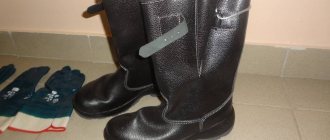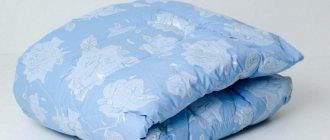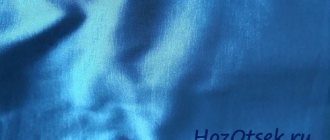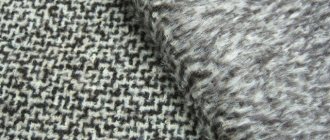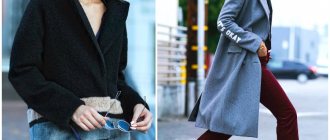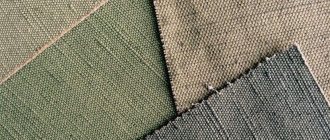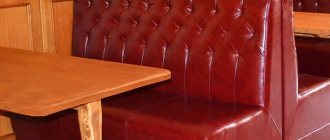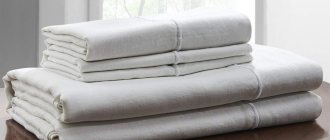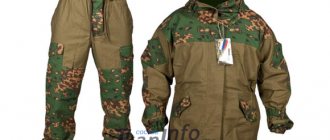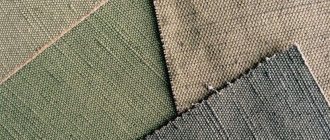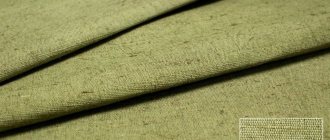Tarpaulin (tarpaulin) fabric: we will give a full description of the material - we will talk about the composition, look at it in different photos, talk about density and properties.
Until recently, tarpaulin fabric, which is not afraid of either water or fire, was the only material that could be used in bad weather conditions. And it is still widely used in the military industry, in the production of travel equipment, ammunition for firefighters, rescuers, etc.
On the site you can find other interesting information and descriptions of all types of woven fabrics.
Characteristics, description and composition
Canvas fabric as in the photo is a natural plain weave material based on cotton, flax or jute. Thick twisted fibers are used for production, which explains its high density. Real tarpaulin is made from mixed cotton and linen fibers and coated with a special water-repellent and fire-resistant impregnation. These are two different types of tarpaulin material that have their own purpose. Tarpaulin fabric has a natural composition with different ratios of linen or jute and cotton threads and the addition of synthetics.
We think you will be interested in reading about Cordura material - they have similar characteristics.
Characteristics and properties:
- tarpaulin fabric density – 300-600 g/m2;
- moisture resistance;
- windproof and dirt-repellent properties;
- strength, tear resistance;
- ability for air exchange;
- environmental friendliness;
- wear resistance.
What is tarpaulin made of?
Before talking about the properties of the material, let's figure out what tarpaulin is made of. This is a woven fabric for which natural coarse fibers are used as raw materials. The basis of the canvases can be cotton, linen, jute fiber, but more often - a mixture of these raw materials. Today, synthetic thread is sometimes added to the composition to lighten the weight of the finished material. However, this has a limited scope of application, since it has less fire resistance.
Depending on what the tarpaulin is made of, it receives texture and density. The most textured fabrics made from jute fiber. If the composition is linen and cotton, the material is smooth. Since it is woven, it allows water to pass through. To give it the required properties - fire resistance or resistance to water, the canvas is treated with a special impregnation.
Regardless of the composition, the properties of different types of tarpaulins are as follows:
- high fabric density;
- weight – from 300 to 900 grams per square meter;
- resistance to moisture and rot;
- resistance to microorganisms;
- frost resistance.
There is no concept of UV resistance for tarps. Natural fibers, unlike polyethylene and polypropylene, do not decompose when exposed to sunlight. The exception is canvases with polymer impregnation: only the top layer is subject to decomposition, while the base (tarpaulin fabric) does not deteriorate under the sun and retains its original strength.
Advantages and disadvantages
Advantages:
- natural composition;
- mechanical tensile strength;
- protection from wind and rain;
- fibers are not destroyed by rot and fungi;
- resistance to high temperatures;
- availability.
The disadvantages of tarpaulin include the fact that, as a result of its high density, thickness and rigidity, clothing and equipment made from it are quite heavy, which makes them not very convenient for movement.
You might be interested in reading about other water-repellent materials.
Types of tarpaulin
The composition determines the properties of the material. Depending on the processing technique, the following types of tarpaulin are distinguished.
Refractory. It is impregnated with a polymer composition, which makes the canvas resistant to open fire. The color of such canopies is brown or brownish-yellow. High-quality material can withstand contact with fire for 90 seconds. None of the synthetic fabrics in a similar price category are capable of this. Does the tarp burn? No, if you expose it to fire for a long time, the threads will begin to break down and holes will appear on the canvas. But it is not capable of ignition, since it is a self-extinguishing material.
Fire-resistant tarpaulin with a density of 480 g/m2, treated with impregnation at the rate of 40 g/m2, is widely used. Its fire resistance time is 50 seconds.
Water resistant. To make the canvas waterproof, it is impregnated with SKVP. This impregnation creates a water-repellent layer on the surface of the canvas with a degree of water resistance up to 3000 mm water column. It also has light resistance, that is, its structure uses light stabilizers that do not allow the polymer to degrade in the sun. It also improves the anti-rot properties of canvases, increasing their resistance to moisture with regular contact with it.
Waterproof tarpaulins with a density of 450 g/m2 are in demand on the market; the impregnation volume is 40 g/m2.
Interesting
Another name for tarpaulin fabric is “canvas”. It comes from the Dutch word “pressening” and is translated as “shell”. Due to the rapid development of the navy, starting from the 15th century, this waterproof canvas material began to be widely used in the manufacture of sails.
Detailed recommendations and tips on how to care for your tarpaulin can be found in the “Care” section. Don't forget to bookmark the site so you don't lose it. Watch a very interesting video on the topic:
What is canvas fabric
Increased strength and technical characteristics that are many times superior to analogues made from synthetic materials: tarpaulin is a fabric for which, despite the development of the polymer industry, they have not been able to find an equivalent replacement. It is massive, dense, tear-resistant, durable. And for a number of industries these features are preferable.
Traditionally it is called canvas, since the canvas was originally used to make sails. Canvas is highly resistant to rotting and serves in adverse weather conditions, exposed to sea spray, rain, salt air and winds for years. Today, the material is used in other areas: canvas has become a thing of the past, while tarpaulin is in demand in construction, manufacturing, cargo transportation, and is indispensable in the manufacture of workwear and shelters.
Wide VO/SKPV tarpaulin. Density 440 g. Width 150 cm
PRICE: 175.50 rub.
per linear meter. Add to cart Water-repellent tarpaulin after treatment with impregnations acquires a green color of various shades. Products made from this material do not allow water to pass through. The water resistance of a fabric is measured in millimeters of water.
Depending on the impregnation, the tarpaulin fabric has the following markings:
- VO – water-repellent, can withstand loads of 10 cm of water column;
- SK – light-resistant material;
- OP – fire-resistant fabric, non-flammable for 35-50 seconds;
- PV is a material with increased waterproof properties;
- SKOP – fire-retardant fabric, resists open flames for over 50 seconds;
- SKPVT – tropical tarpaulin;
- SKP is a biostable material with water-resistant properties;
- SKPV is a highly water-repellent fabric that can withstand up to 25 cm of water. Art.
The variety of types of canvas fabrics produced by textile factories allows them to be used in various fields of industry, services, and for domestic purposes.
Tarpaulin fabric: advantages, scope.
Durable fabric made from natural plant threads is in demand due to its advantages:
- low cost;
- increased wear resistance;
- low hygroscopicity;
- resistance to temperature changes;
- fire resistance;
- breathability;
- environmental friendliness of the material.
Fabric with high strength characteristics allows the product to be used for a long period of time. The material resists mechanical stress well and does not lose its properties in natural conditions. The affordable cost of the fabric allows the fabric to be used for household and industrial purposes. Main Applications:
- construction industry;
- Agriculture;
- military sphere;
- metallurgy;
- tailoring of workwear.
Tarpaulin and products made from this fabric are widely used to create temporary shelters. Crops and building materials are stored under awnings from bad weather. Clothes made of durable fabric are indispensable equipment for firefighters, metallurgists, and welders. Products made from canvas are popular among fishermen, hunters, tourists, and car enthusiasts.
Where is it profitable to buy tarpaulin?
It is more economical to purchase canvas from manufacturers. The website salfetka-tehnicheskaya.ru presents a wide range of tarpaulin fabrics for various purposes. The company offers interested customers its own products in rolls with the following parameters:
- width 90; 150; 160cm;
- density from 240 g/m²;
- length per roll from 80m;
- cost per m² from 50 rub.
The catalog contains varieties of tarpaulins of various brands. The material is made of linen type film in accordance with regulatory requirements. The length of the rolls varies from 50 to 125 meters. The colors of fabrics depend on the impregnating compounds that give the fabrics special properties.
The company offers high-quality canvas for the manufacture of workwear with fire-resistant properties. Enterprises producing awnings, tents, and covers will benefit from SKPV brand canvas, which reliably protects from moisture and has water-repellent properties.
To ensure excavation and field work, bioresistant brands of canvas that resist the negative effects of the environment for a long period of time are suitable.
TABLE OF CARGO PARAMETERS for calculating the cost of transportation | ||||||||
| Description of goods | vendor code | Density (g/sq.m.) | Roll length (m) | Roll width (m) | Roll height (m) | Roll volume (m³) | Roll weight (kg) | Approximate quantity per roll (m) |
| Harsh tarpaulin | 11135 D | 240 | 0,9 | 0,40 | 0,20 | 0,07 | 24,00 | 80 |
| Harsh tarpaulin | 11135 s | 280 | 0,9 | 0,42 | 0,22 | 0,08 | 27,00 | 80 |
| Harsh tarpaulin | 255 s | 330 | 0,9 | 0,42 | 0,22 | 0,08 | 31,00 | 80 |
| Tarpaulin OP | 11135 D | 340 | 0,9 | 0,42 | 0,22 | 0,08 | 24,00 | 80 |
| OP tarpaulin with | 11135 | 380 | 0,9 | 0,42 | 0,22 | 0,08 | 27,00 | 80 |
| Tarpaulin OP n | 11135 | 420 | 0,9 | 0,42 | 0,22 | 0,08 | 30,00 | 80 |
| OP tarpaulin with | 255 | 430 | 0,9 | 0,42 | 0,22 | 0,08 | 31,00 | 80 |
| Tarpaulin OP n | 255 | 450 | 0,9 | 0,42 | 0,22 | 0,08 | 32,00 | 80 |
| VO/SKPV tarpaulin with | 255 | 360 | 0,9 | 0,42 | 0,22 | 0,08 | 26,00 | 80 |
| Tarpaulin VO/SKPV n | 255 | 390 | 0,9 | 0,42 | 0,22 | 0,08 | 28,00 | 80 |
| VO/SKPV tarpaulin | 11293 | 400 | 0,9 | 0,44 | 0,24 | 0,09 | 29,00 | 80 |
| Tarpaulin OP | 11293 | 480 | 0,9 | 0,44 | 0,24 | 0,09 | 26,00 | 60 |
| Tarpaulin OP | 11292 | 530 | 0,9 | 0,44 | 0,24 | 0,09 | 28,00 | 60 |
| VO/SKPV tarpaulin | 11292 | 450 | 0,9 | 0,44 | 0,24 | 0,09 | 32,00 | 80 |
| Tarpaulin OP | 11252 | 660 | 0,9 | 0,42 | 0,22 | 0,08 | 30,00 | 50 |
| VO/SKPV tarpaulin | 11252 | 590 | 0,9 | 0,40 | 0,20 | 0,07 | 26,00 | 50 |
| Tarpaulin OP | 1P1135 | 400 | 0,9 | 0,45 | 0,24 | 0,10 | 39,00 | 100-125 |
| Tarpaulin OP | 11255 | 460 | 0,9 | 0,45 | 0,24 | 0,10 | 43,00 | 100-110 |
| Tarpaulin VO | 11255 | 460 | 0,9 | 0,45 | 0,24 | 0,10 | 44,00 | 110-125 |
| OP wide tarpaulin | OP/150 | 430 | 1,5 | 0,33 | 0,16 | 0,05 | 29,00 | 40-50 |
| OP wide tarpaulin | 11293 | 480 | 1,6 | 0,33 | 0,16 | 0,05 | 34,00 | 40-50 |
| Wide VO/SKPV tarpaulin | VO/150 | 350 | 1,5 | 0,33 | 0,16 | 0,05 | 24,00 | 40-50 |
Tarpaulin fabric: main varieties, markings.
In which industries is it used?
Tarpaulin canopies developed in accordance with GOST are used in many sectors of human activity. At the time of its creation, canvas was used mainly in shipbuilding, but over time, tarpaulin spread to:
- Production of specialized clothing - suits, mittens, raincoats for construction workers. Tarpaulin is actively used in the creation of protective clothing for fire-fighting welders and metallurgists due to its ability to withstand the effects of fire, sparks, etc.
- Agricultural sectors - tarpaulin canopies are actively used to cover agricultural crops. Office vehicles are stored under them and equipment is protected from corrosion, since the awning will not allow moisture to pass through. Another application in agriculture is that a tarpaulin canopy is suitable for covering crops.
- In construction, tarpaulin is used in the construction of temporary canopies; building materials and buildings are stored under tarpaulin canopies with eyelets, completely protecting them from the negative effects of the environment. In addition, the material is actively used in the construction of fences, slopes, and formwork when heating concrete joints.
- In military affairs, the production of canvas awnings began during the Second World War. In those days, canvas replaced leather, which was too expensive during military operations. Belts, belts, and boots for soldiers were made from tarpaulin.
Now tarpaulin is used by fishermen, hunting enthusiasts, summer residents and motorists. Tents, backpacks, canvas for covering supplies, chairs for tourism, etc. are made from it. Most of the elements of ammunition continue to be made from canvas. Every item made from it is durable, practical and does not require special care.
In you can purchase tarpaulins of Russian and foreign production. All materials are made from the highest quality raw materials and have passed appropriate tests. If necessary, our managers will advise you and select the best tarpaulin awnings for your garden, home or travel.
Description of semi-linen canvas (tarpaulin)
Close-up photo of tarpaulin
Semi-linen canvas, or as it is more often called, tarpaulin, is used in many areas of life, in construction, in production, in the army, etc., the list is huge. Many people have probably encountered this fabric in one way or another. In this article we will tell you what types of tarpaulin there are
, what characteristics it has, how it differs, what it is used for. I would like to note right away that not all possible ways of using tarpaulins will be described here, but only those that I know about.
Tarpaulin impregnation
First, let's talk about canvas impregnations. Here are the types of tarpaulin impregnations:
- OP - Fireproof Impregnation, indicates that the tarpaulin has a certain resistance to fire, depending on the article - 35 or 50 seconds. (if the tarpaulin complies with GOST 15530-93), if the tarpaulin is produced according to the manufacturer’s specifications, then this parameter may differ. Further, all values will be indicated for tarpaulins manufactured in accordance with GOST 15530-93.
- VO - Water-repellent impregnation, with such impregnation the tarpaulin must withstand up to 100 mm of water column.
- SKPV - Light-resistant Combined High Water Resistance, withstands from 125 mm to 250 mm depending on the article.
- SCOP - Light-resistant Combined with Increased Fire Resistance, fire resistance for more than 50 seconds.
Using canvas curtains to protect premises during the cold season
During the cold season, curtains made of tarpaulin are often placed in the windows and openings of warehouses or other utility rooms. The Tarpaulin curtain is an inexpensive option for industrial curtains that have a high density. It allows you to protect the interior from the penetration of cold air and drafts, and also perfectly retains heat inside the building.
The Tarpaulin curtain is impregnated with a special water-repellent composition and is slightly airtight. Thanks to the high density of interwoven threads and special impregnations, such a tarpaulin does not allow moisture to pass into the room even during heavy rainfall.
Tarpaulin curtains can also have fire-fighting properties when using fire-resistant impregnation. Due to their high wear resistance, such curtains can be used for several seasons. To hang curtains on a beam or hook, metal eyelets are placed along one edge of the panel. The bottom edge of the curtains is hemmed using lavsan threads. This allows you to strengthen the edge and make the entire product more neat.
Tarpaulin products are widely used for insulation of warehouses, industrial workshops, transport terminals, and garages. Also, tarpaulin curtains are often placed in gazebos and open verandas. In this case, they are the best alternative to glazing, as they are low cost and very easy to install.
Material characteristics
The distinctive properties of the material are:
- 1. Reliability. The material is strong and durable.
- 2.Wear resistance. Tarpaulins withstand compression, stretching, bending and friction.
- 3.Low hygroscopicity. The fabric does not absorb water, which ensures the safety of the materials covered with it.
- 4.Breathability. It allows air to pass through, creating an optimal microclimate.
- 5.Resistant to temperature changes and weather conditions. Can be used in rain, snow, frost, strong wind or high temperature.
